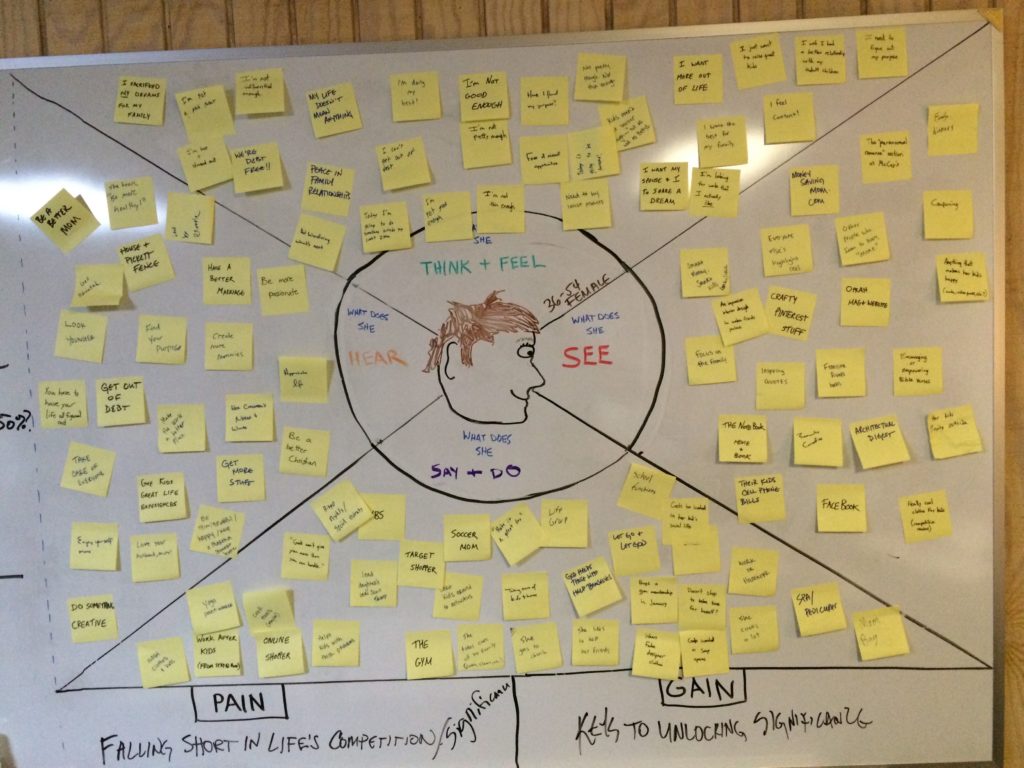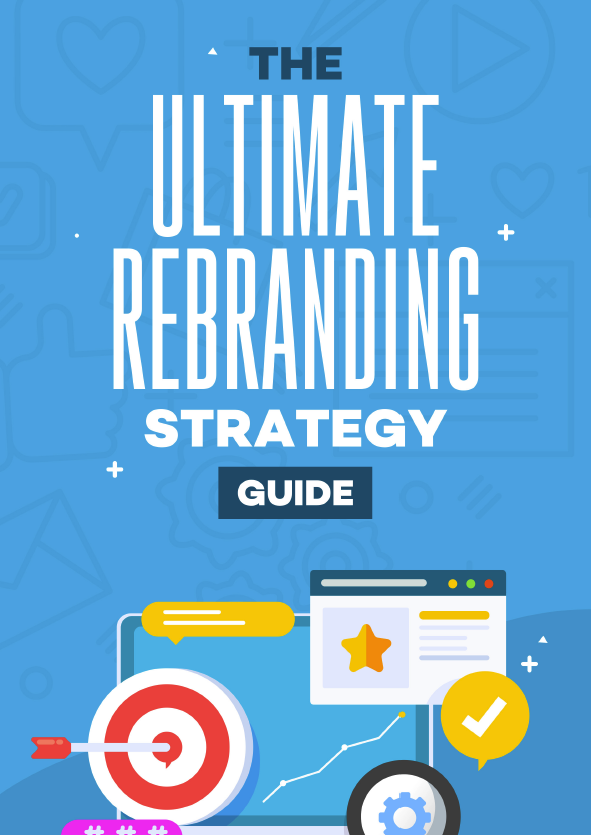“Know your target audience” is common marketing advice, but it’s vague.
We’re all good marketers here. We know it’s important to understand our audience.
But how do we get from a general picture like…
“Greg is our customer avatar. He’s 45 and loves to shop at Sears.”
(Greg, you can do better than Sears. I believe in you.)
To…
“One of the biggest problems in Greg’s life is his lack of confidence at work. He knows he has something valuable to say, but he’s tired of getting talked over and is almost at the end of his rope. He desperately wants to know how to gain respect at work without compromising his friendly nature.”
???
That seems like a big jump, but not if you have the right tools.
In fact, one of the most effective tools we use to understand the emotional position our customers are coming from is an Empathy Map.
If that’s a new term to you, no worries.
In this post, we’re going to cover exactly what an empathy map is, how it can help your marketing efforts, what an empathy map example looks like, and…
I’ll even give you our complete empathy map template, along with a 4-step guide that shows you exactly how to use it to understand your audience better.
What is an Empathy Map?
Dave Gray first developed the Empathy Map as a tool to understand users in a development setting. (Think user interface.)
That includes what they…
- Think
- See
- Hear
- Say
- Do
…while using your product.
By thinking through and visually exploring these things, you are able to develop a customized experience for them.
We use an Empathy Map to understand our customers on a deeper level, but instead of analyzing how they interact with our product…
We look at how they interact with the outside world.
If that sounds vague, think of the Empathy Map as a way to walk a mile in your customer’s shoes.
Quick note: All the advice in this article assumes you have correctly identified your ideal customer. For this process, we use our brand strategy template, which you can find here.
When you create an Empathy Map for marketing purposes, you think through what your target customer…
- Thinks
- Sees
- Hears
- Says
- Does
…in his/her daily life.
As a result, you develop empathy for that person. (Duh!)
All that information gives you insight into what your target customer feels.
This is the beauty of the map.
By going through the exercise, you can start to identify the things that are holding your customer back — their biggest pains.
Then, you can transform those pains into the biggest wins your customer can experience — their biggest potential gains.
It’s almost like you’re able to wave a magic wand to fix the biggest problem your customer is experiencing.
Your product, app, or book can speak directly to that problem and provide the clearest way to overcome it!
This is extremely powerful. In fact, it’s the essence of effective marketing.
We believe building an empathy map is an absolute necessity if you want to get into the mind of your target audience, which is extremely helpful when you’re launching a product, service, or new business.
It’s crucial for both marketing copy and user experience.
Let’s dive into some examples.
Empathy Map Examples

Let’s talk about Bliss Spa for a moment.
Bliss was built on customer service and amazing experience, but the thing about Bliss that really stood apart (and made it a worthwhile purchase for two major brands in the early 2000s) was this…
Bliss understood its target customer to the fullest extent.
Marcia Kilgore built Bliss on the idea that there was a woman who wanted to go to the spa on a semi-regular occasion.
She didn’t view the experience as a necessary part of her weekly schedule. But she still wanted it as something to look forward to after a stressful week or to celebrate a success.
That woman heard:
- That she looked tired
- That her skin was blotchy
- The demands of her bosses, spouse, or kids
She saw:
- The celebrities with perfect skin
- The spa in her neighborhood that everyone raved about
- Her face in the mirror (especially the imperfections she focused on)
She thought:
- She deserved a treat
- She was tired and needed rest
- Her time was precious
She did:
- Go to spas!
Her pain: The trouble of the world that showed up on her face
Her gain: A restful, rejuvenating experience
But imagine how jarring it was when she showed up a spa and was told…
How awful her skin looked…
How much treatment she needed…
And how much time she needed to carve out to adjust to the spa’s schedule.
That’s how Bliss’ competitors were treating their customers.
So Marcia built a spa that catered to the woman’s time, took as much time as needed for an outstanding treatment, and left the woman feeling better than when she came in.
This shouldn’t have been revolutionary, but it was!
By focusing on her target customer, Marcia built a hugely successful business. She also expanded beyond that target customer to pick up a large portion of her market.
When you use an empathy map to focus on your target customer, you can speak their language, and more importantly—
Solve their biggest pain point!
A Less Successful Implementation…
Getting your target market exactly right doesn’t guarantee success.
Think about the Fyre Festival.
Billy McFarland nailed his target market.
That person:
- Sees the lives of the rich and famous
- Hears the amazing experiences his/her rich friends are having
- Thinks about significance and their outward appearance
- Says they have the financial means to afford luxury experiences
- Does things to show status
This is exactly the kind of person to whom the marketing of the Fyre Festival appealed.
But, while Billy got his target market right, he didn’t deliver what he promised. (We generally call that fraud.)
This is probably a good time to note that your target market can see fraud.
Don’t lie to get them. Be sincere and attract them to your brand by providing real value — not just effective marketing.
How to Use an Empathy Map (4-Step Guide)
Now, it’s time for you to supercharge your marketing.
It’s time to set time aside to get into the head of your target customer.
It’s time to build your own Empathy Map.
Step 1: Set aside 1 hour (Yes, one whole hour)
It may take longer than an hour, but that doesn’t really matter.
This is the most important time you’ll spend on marketing this year.
Make sure the hour that you set aside is protected. Turn off email and notifications. Get in the mindset to brainstorm.
Step 2: Gather your team
Who you have in the room may be even more important than the time you set aside.
Make sure the people involved represent different points of view. And if you have someone on your team who is in the target market, that’s all the better.
Step 3: Print out this template
We’ve found that, in these settings, there is something powerful about the physical pen and paper you’re using.
So, print these out. Don’t isolate yourself to a screen.
Have a whiteboard?
Make your own version of the Empathy Map on that.
We’ve even used Post-Its, so each team member can write his/her ideas down.
Two important things to remember as you write these thoughts down:
1. There are no wrong answers (initially)
Eventually, you may find that some of the things you thought were important to the target market are not.
But in this moment, it’s more important to get all the potential thoughts, rather than only the correct thoughts.
This is simply because you may stumble across something you wouldn’t have come across had you only been trying to provide “correct” answers.
2. Spend time on each quadrant. Don’t try to do them all at once.
Self-explanatory.
Step 4: Validate and use the results
This is where you investigate the ideas you had in the brainstorming session.
Do the research. Look at what your target customer is saying online. Talk to them.
Then — and I can’t stress this enough — use your research in your marketing.
Let it guide you when you’re making a decision about what channels to focus on, what your ads should look like, and how your sales copy should read.
An Empathy Map without implementation is useless.
Like I mentioned above, having your team spend this dedicated time thinking about your target customer will be the most important marketing activity you do this year.
Invest the time to do this well. The results will be well worth it.
You’ve got some homework to do. Go get started!

